The Intricacies of 925 Ec Rings and Their Value
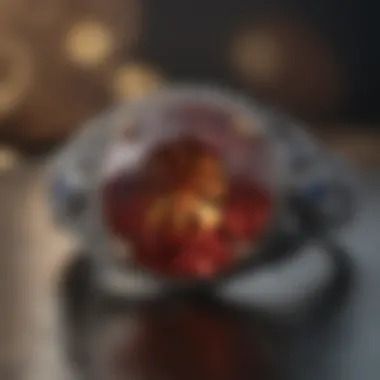
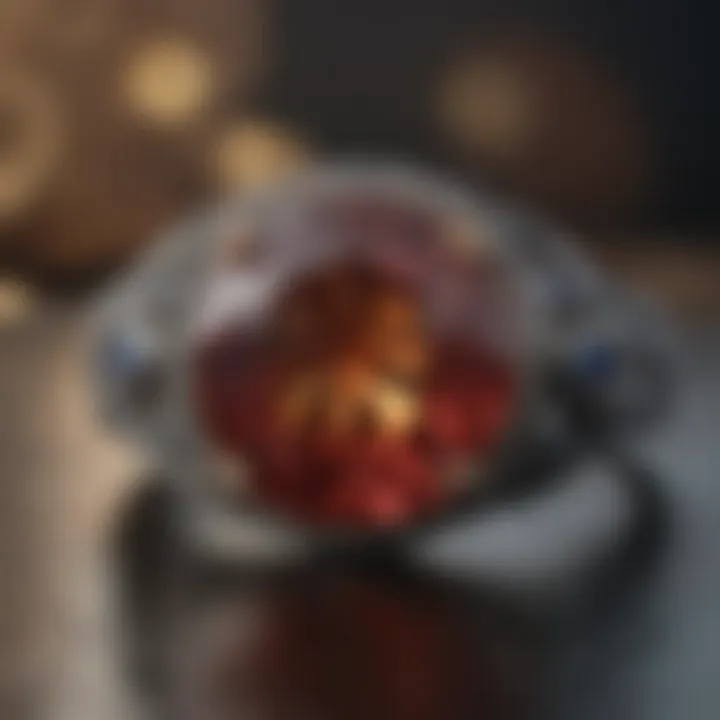
Intro
In the intricate world of jewelry, few pieces hold as much allure and esteem as 925 ec rings. These rings stand not only as symbols of beauty and elegance but also as artifacts of craftsmanship and cultural significance. To truly appreciate the value of a 925 ec ring, one must delve beyond the surface. By understanding the characteristics of the gemstones set in these rings, their unique properties, and the factors that contribute to their market valuation, enthusiasts and collectors alike can foster a richer connection to these treasures.
Gemstone Overview
When we talk about 925 ec rings, we must first examine the gemstones that adorn them. In its essence, a gemstone can be defined as a naturally occurring crystalline substance, valued for its beauty, rarity, and durability. Most gemstones share certain characteristics that make them desirable, such as aesthetic appeal, rarity, and the ability to withstand wear and tear.
Definition and characteristics
Gemstones can range from the well-known, like diamonds and sapphires, to more obscure choices such as tsavorite or spodumene. Here are a few defining features that characterize gemstones:
- Luster: The way a gemstone reflects light, which can be glossy, dull, or resinous.
- Color: The hue is perhaps the most prominent aspect, influenced by impurities and the crystal structure.
- Transparency: Ranging from transparent to opaque, this affects the stone's clarity and visual appeal.
Additionally, each gemstone boasts a unique story, often intertwined with emotions and traditions, enhancing its value in the jewelry market.
Classification of gemstones
Gemstones are commonly classified into two categories: precious and semi-precious. While the lines between these classifications have blurred over time, they still hold relevance in the jewelry industry.
- Precious gemstones: This group includes diamonds, sapphires, rubies, and emeralds. These stones are rare and tend to carry higher market values.
- Semi-precious gemstones: A broader category that encompasses a variety of stones like amethyst, garnet, and topaz. While they may be more affordable, they still possess unique beauty and charm.
The classification impacts consumer choices and perceptions, shaping the market’s landscape.
Properties of Gemstones
The value that gemstones bring to 925 ec rings is not merely in their visual beauty. Their physical and chemical properties play a significant role in shaping their desirability and longevity.
Physical properties
Physical properties of gemstones include hardness, specific gravity, and cleavage, which define how they react under various conditions. For instance, the Mohs scale of hardness indicates how resistant a gemstone is to scratching. Knowing these properties can guide collectors and enthusiasts in their pursuit of durable and aesthetically pleasing jewels.
Chemical properties
On the flip side, the chemical properties denote the elemental composition and structure of gemstones. For example, diamonds are composed of carbon, while sapphires contain aluminum and oxygen. Understanding these components can enhance the appreciation of each stone, shedding light on aspects such as origin, rarity, and even ethical considerations in the mining process.
"Understanding the intrinsic properties of gemstones elevates one’s appreciation and fosters informed decision-making in the world of jewelry."
In summary, the journey to recognize the value of 925 ec rings begins with a deep dive into the fascinating world of gemstones. By grasping the characteristics and values embedded in the gemstones, enthusiasts can enrich their experience in the jewelry market.
Prelims to Ec Rings
Understanding 925 Ec rings goes beyond mere aesthetics; these pieces encapsulate a blend of cultural relevance and significant craftsmanship. The value of these rings is sensed not just in their physical beauty but also in their ability to tell a story. Every 925 Ec ring holds a unique narrative, woven from its materials, design, and the cultural context from which it originates. For jewelry enthusiasts and collectors alike, diving into the world of 925 Ec rings provides a deeper appreciation for what they wear and how they showcase personal style.
In discussing the importance of 925 Ec rings, one must recognize how they navigate the complex landscape of jewelry. They have both historical and contemporary significance, often seen as heirlooms passed down through generations or cherished personal statements in today's fashion-forward world.
Definition of Ec Rings
A 925 Ec ring, commonly referred to as sterling silver, is a type of ring composed of 92.5% silver and 7.5% other metals, usually copper. This specific alloy is key, as pure silver, despite its luster, is too soft for practical use in jewelry. The added metals enhance durability, making these rings more resilient while still maintaining a beautiful sheen. The term "ec" often indicates a design ethos that emphasizes eco-friendly practices, which has gained traction in recent times among conscious consumers.
Historical Context
Historically, silver has held a prestigious place in various cultures, often regarded as a symbol of wealth and purity. The origins of using silver in jewelry can be traced back to ancient civilizations; for instance, the Egyptians adorned themselves with silver jewelry as early as 3000 B.C. The introduction of sterling silver in the Middle Ages was a pivotal moment in jewelry-making, setting a standard that still resonates today. In fact, the hallmark system was established around this time to designate the purity of silver articles, ensuring authenticity and quality.
In modern times, the rise of ethical consumerism has prompted many artisans and jewelers to adopt sustainable practices in creating 925 Ec rings. These trends emphasize the historical context while opening paths to potential future developments in the industry. The dialogue around jewelry has shiftd, as consumers increasingly seek items that align with their values.
"925 Ec rings are not just accessories; they are cultural artifacts that reflect the values and technology of their time."
With an understanding of the definition and historical backdrop of 925 Ec rings, one can appreciate the depth of meaning embedded in these seemingly simple pieces of jewelry.
Composition of Ec Rings
The composition of 925 ec rings plays a pivotal role in understanding their value and unique appeal. This section illuminates the very elements that define these rings—essential information for the discerning enthusiast and collector. By grasping the hallmark 925, the metal's quality, and the resulting aesthetics, one can appreciate the true craftsmanship behind each piece.
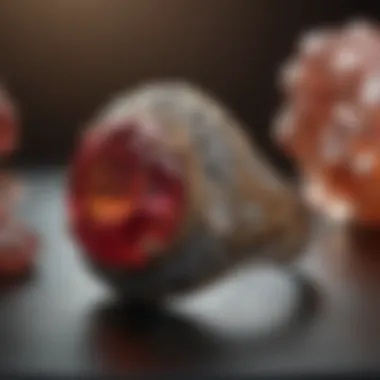
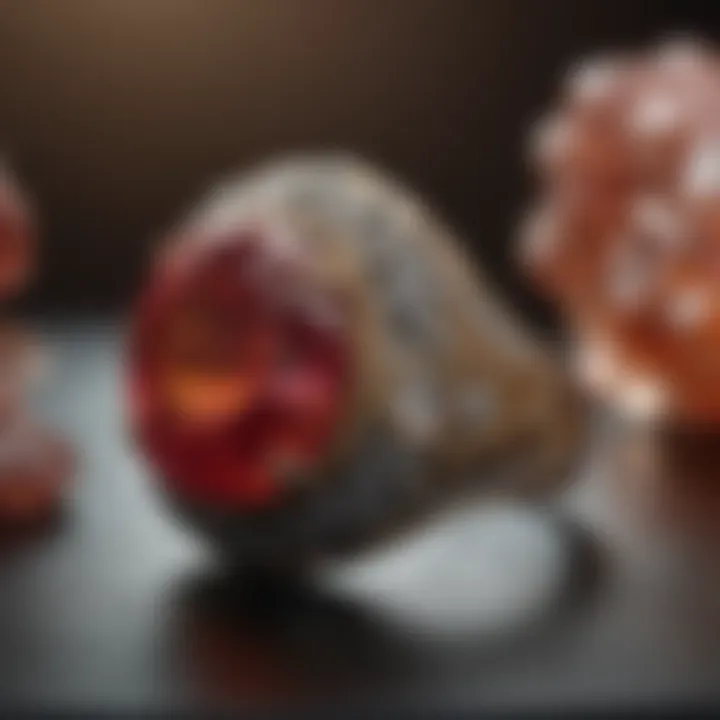
Understanding Sterling Silver
Sterling silver, widely recognized for its sheen and luster, is a critical component in the creation of 925 ec rings. The term "sterling" indicates that the metal contains 92.5% pure silver, with the remaining 7.5% typically made up of other metals, most commonly copper. This combination not only enhances the strength and durability of the rings but also affects their brilliance.
The allure of sterling silver lies in its versatility; whether polished to a mirror finish or given a matte texture, it can adapt to different styles. The right mixture contributes to its longevity, ensuring it withstands daily wear while retaining its aesthetic appeal. Consequently, the high silver content certifies its value, making it a preferred choice among jewelry makers.
Alloy Composition
Diving deeper into the alloy composition, it’s crucial to highlight how the mix of metals influences both the appearance and functionality. The addition of copper, as mentioned earlier, is not merely incidental; it serves several purposes.
- Strength: Copper makes the sterling silver harder and less prone to scratching or bending, extending the life of the jewelry piece.
- Color Retention: Different alloys can modify color nuances, impacting the final look of the rings. For instance, adding nickel results in a whiter appearance, while higher gold content can yield a warmer hue.
- Tarnish Resistance: The 7.5% of additional metals can help reduce tarnishing. However, certain combinations might not yield this benefit, highlighting the need for consumers to be informed.
It's important to note that the specific alloy combination can vary among manufacturers, thus influencing the overall quality and characteristics of the jewelry. Therefore, collectors are advised to investigate the materials used in their 925 ec rings carefully.
Impact of Rhodium Plating
Another significant element impacting the composition is rhodium plating. This process involves coating the sterling silver with a thin layer of rhodium, a member of the platinum family known for its brilliant white finish and reflective quality.
Rhodium plating not only enhances the visual appeal of 925 ec rings, but it also offers
protection against scratches, tarnish, and corrosion.
- Aesthetic Appeal: Rhodium adds an extra shine that elevates the overall look of the ring. For many, the goal is to achieve a polished, expensive appearance without the hefty price tag.
- Durability: This plating can significantly increase the ring's lifespan, ensuring that the beauty remains intact even with regular use.
- Maintenance: While rhodium provides great benefits, it can wear over time, requiring occasional re-plating to maintain that lustrous finish.
Craftsmanship and Design
When diving into the realm of 925 ec rings, one quickly realizes that craftsmanship and design are the heart and soul of these exquisite pieces. The delicate interplay between skillful artistry and modern design elements defines the allure of these rings, making them not only adornments but also reflections of creativity and personality. Every detail, from the choice of materials to the intricate finishing touches, plays a vital role in the overall value and desirability of these rings.
Techniques Used in Jewelry Making
Jewelry making is an age-old craft that combines artistry with technical skills. Several techniques are utilized in creating 925 ec rings, and understanding these methods can greatly enhance appreciation and knowledge about their value.
- Soldering: This is a fundamental technique where pieces of metal are joined together using heat. The precision in soldering impacts the integrity of the ring's structure, making it durable and long-lasting.
- Casting: Many jewelers use casting to shape the silver into desired forms. This involves pouring molten metal into a mold, which allows for intricate designs that might be challenging to achieve through other methods.
- Stone Setting: Be it a diamond or a more unusual gemstone, setting stones requires an artist's touch. The way a gem is set can affect how light interacts with it, thus impacting its brilliance and overall aesthetic appeal.
- Polishing: A well-polished ring catches the eye and reflects a jeweler’s precise attention to detail. This step ensures that the final product shines beautifully, adding to its visual allure.
Design Trends in Ec Rings
As consumer tastes evolve, so do the designs of 925 ec rings. Staying updated on current trends can offer insights into the market's dynamics and the future direction of jewelry design.
- Minimalist Aesthetics: In recent years, a shift towards minimalist styles has gained traction. Simple, clean lines often create a modern look that resonates well with a broad audience. This trend embraces the principle that "less is more" while allowing the beauty of the material to shine.
- Nature-Inspired Designs: Many designers have drawn inspiration from nature, incorporating organic shapes and motifs. Floral patterns or designs that mimic natural elements like leaves or waves are becoming increasingly popular. This aligns with a growing consumer preference for pieces that connect them to the environment.
- Personalization: Consumers are now gravitating towards rings that tell a story or hold personal significance. Customization options, such as engravings or the use of specific birthstones, are highly valued. This trend underscores the desire for unique items that reflect individual identities.
Craftsmanship isn't just about making jewelry; it's about creating pieces that resonate with the heart and soul of those who wear them.
In summary, understanding the craftsmanship and design behind 925 ec rings enhances not only the appreciation but also the informed decision-making when it comes to purchasing and collecting. The techniques of jewelry making mark the foundation of quality, while current design trends guide buyers toward pieces that resonate with contemporary tastes.
Cultural and Symbolic Significance
The cultural and symbolic significance of jewelry, and specifically 925 ec rings, is a lens through which one can appreciate not just their intrinsic value but also the narratives and traditions they represent. These rings often serve as tokens of love, commitment, and personal expression, weaving stories that connect individuals to their cultural backgrounds, family histories, and significant life events. The understanding of this aspect is essential for gem enthusiasts and collectors alike, as it adds a layer of depth to why these rings are cherished.
Cultural Interpretations of Jewelry
Jewelry transcends mere aesthetics; it often embodies the essence of cultural identity. In many societies, rings are seen as representations of status, wealth, or achievement. In cultures such as the Maasai in Kenya, jewelry has a profound meaning tied to community and social standing. A ring's craftsmanship can reflect the region's traditions, with designs that may signify historical events or spiritual beliefs.
Furthermore, the act of gift-giving is deeply embedded in the fabric of various celebrations. For example, in many Western cultures, an engagement ring is not just a piece of jewelry but a cherished symbol of a promise. Similarly, in India, rings play a role in rituals associated with marriage, representing auspicious beginnings and familial bonds.
When considering 925 ec rings, it's worth noting their significance in modern contexts as well. Increasingly, consumers are drawn to eco-friendly and ethically sourced materials, reshaping the cultural narrative around jewelry to honor not just the past but also the future. This approach reflects growing awareness and sensitivity towards sustainability in culture.
Symbolism Associated with Rings
Rings carry powerful symbolism that can vary across different cultures, but some meanings hold universal significance. The circular shape of a ring is often interpreted as a symbol of eternity, representing an unbroken bond. This is particularly evident in wedding and engagement rings, where the exchange signifies commitment and the cycle of life and love.
On a more personal level, individuals might wear rings as talismans for protection or good fortune. In various cultures, specific materials or stones are believed to hold unique properties. For instance, a ring crafted from silver, like a 925 ec ring, may be thought to promote healing and balance, due to silver's connection with the moon and its reflective qualities.
To summarize, the cultural and symbolic significance of 925 ec rings extends far beyond their material composition. They are emblematic of personal stories and collective traditions. As consumers become more aware of the implications of their purchases, understanding these narratives can enrich one’s appreciation and connection to the jewelry they choose to wear.
"Jewelry is not just adornment; it is a narrative that weaves through individual experiences and shared histories."
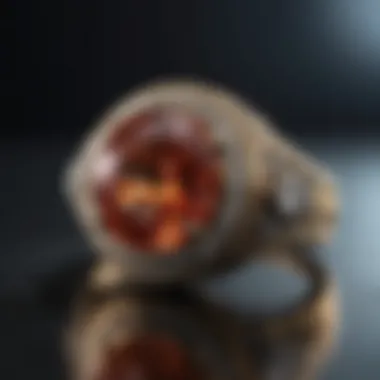
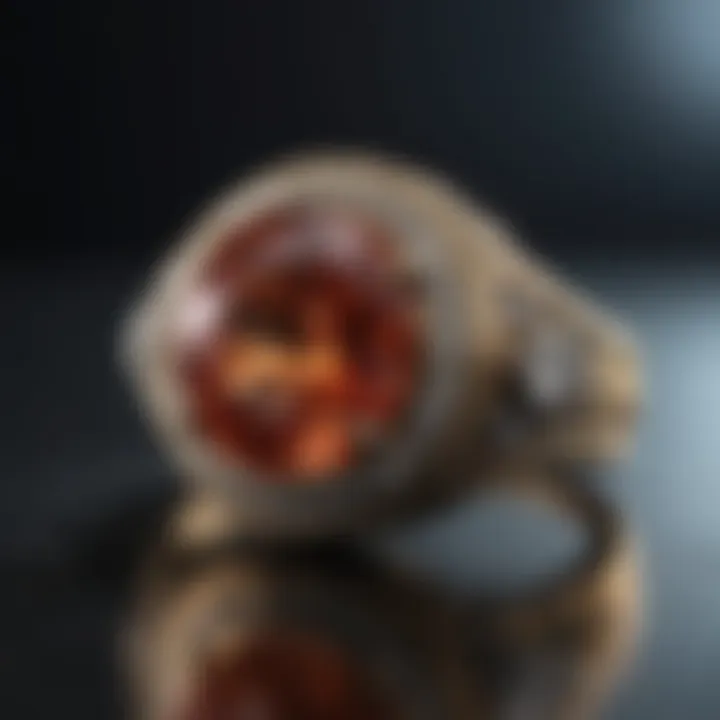
In a world where personal expression through items is invaluable, recognizing the cultural context of rings can elevate the experience of owning and gifting 925 ec rings.
Market Value of Ec Rings
Understanding the market value of 925 ec rings is pivotal for anyone interested in jewelry. It serves as a litmus test for quality and desirability in a vast sea of options available today. Investing in these rings isn’t just about beauty; it’s also about knowing their worth in a fluctuating market. The value of 925 ec rings can be influenced by a myriad of factors, including craftsmanship, market trends, and even consumer preferences. This section dives into what makes these rings significant in the marketplace.
Factors Influencing Value
Various elements contribute to the market value of 925 ec rings, and it's essential to recognize them:
- Material Composition: As evident from the name, 925 sterling silver is 92.5% pure silver. This purity significantly affects the price. The market often prizes higher purity, correlating with value.
- Brand Reputation: Certain manufacturers or designers hold a superior reputation, naturally boosting the perceived value of their rings. A ring from a renowned brand can command a premium simply due to the label attached to it.
- Craftsmanship: The quality of work put into each piece can vary widely. 925 ec rings that exhibit intricate designs or superior finishing typically fetch higher prices compared to more standard designs.
- Rarity: Limited edition releases or unique pieces can drive demand sky-high. Collectors often seek rare variants, which can lead to inflated pricing in auctions or resale markets.
- Market Conditions: Like any other commodity, the silver market fluctuates. Economic conditions can sway the pricing of silver, which subsequently impacts the prices of 925 ec rings.
"The value of jewelry reflects more than just the materials; it embodies artistry and history as well."
Price Range and Market Trends
Navigating the price range of 925 ec rings can seem daunting at first. Generally, prices can vary from as low as fifty dollars for simpler designs to several thousand dollars for pieces that boast elaborate craftsmanship or gemstones.
- Entry-Level Rings: These are typically straightforward designs made with minimal embellishments. Prices might hover around $50-$200. They're perfect for those looking for something stylish without breaking the bank.
- Mid-Range Rings: Encompassing more intricate designs with better craftsmanship, these rings can range from $200 to $800. Here, you start to see a blend of aesthetic appeal and quality.
- High-End Rings: These pieces frequently feature elaborate settings, unique designs, or additional materials like gemstones or diamonds. Prices often start at $800 and can surpass $3000, depending on what you’re getting.
Tracking market trends can be beneficial to potential buyers and sellers. Currently, there's a growing trend towards ethical sourcing and sustainable practices in the jewelry industry. Consumers are becoming increasingly aware of where their materials come from, which adds another layer of complexity to the value of 925 ec rings.
In summary, understanding the market value of 925 ec rings involves grasping the various factors influencing pricing, as well as recognizing the current market trends that can dictate how these rings are valued in the eyes of consumers and collectors alike.
Comparative Analysis with Other Rings
Understanding the realm of 925 ec rings requires more than just a surface-level glance. By diving into a comparative analysis with other rings, we can appreciate the unique qualities and nuances that define 925 ec rings in the larger jewelry market. This not only sheds light on their distinctiveness but also allows consumers to make informed choices based on their preferences and the characteristics that matter most to them.
Ec Rings vs. Other Silver Jewelry
When placing 925 ec rings alongside other forms of silver jewelry, key differences appear:
- Purity and Composition: At the core, 925 ec rings are composed of 92.5% silver and 7.5% of other metals, typically copper. This stands in stark contrast to items labeled simply as silver, which could mean a range of purities, often lower than the sought-after sterling standard.
- Durability: While sterling silver tends to tarnish without proper maintenance, 925 ec rings are often strengthened with various alloys, enhancing their longevity. The added metals can help resist scratches and deformation, giving these pieces a sturdier feel.
- Cost Effectiveness: Pricing can vary significantly across different silver jewelry types. 925 ec rings might present a more affordable yet superior option compared to higher-priced fine jewelry, making them appealing to a wider audience. Yet, this doesn't mean a compromise in aesthetics or quality—many designs offer elegance without breaking the bank.
- Design Complexity: Typically, 925 ec rings come with a richer array of intricate and specialized designs, thanks to advancements in crafting techniques. This can set them apart from simpler silver bands or charms that may saturate today's market.
Consumers looking for sheer elegance and durability may find that 925 ec rings outshine their more traditional counterparts, resonating well with those who wish to combine style and substance.
Distinctive Characteristics of Ec Rings
925 ec rings boast several distinctive traits that elevate their standing in jewelry collections:
- Signature Mark: A hallmark of authenticity often found in these rings is the "925" stamp, a testament to their silver content. This marking instills confidence in both buyers and collectors, ensuring that what they possess is genuine.
- Rhodium Plating: A common enhancement seen in many 925 ec rings is rhodium plating. This process not only imbues the rings with a trendy, shiny finish but also offers a level of tarnish resistance, promoting their understated elegance.
- Versatility in Style: These rings are famed for offering a massive array of styles, ranging from minimalist to ornate designs. Such diversity allows for the ring to be suitable for any occasion, from casual outings to formal events.
- Symbolic Attributes: 925 ec rings often carry rich symbolism, representing everything from commitment to personal achievements. This deeper layer of meaning often resonates on a more personal level with wearers and collectors alike.
As one explores the characteristics and comparisons, it becomes clear that 925 ec rings stand out in the crowded landscape of jewelry. They blend quality, aesthetic appeal, and symbolic depth, making them a timeless piece for enthusiasts and collectors.
"Collecting 925 ec rings is not just about adornment; it’s about embracing a piece of art that tells a story."
The exploration of their characteristics and the critical comparisons to other jewelry types allows collectors not just to make purchases but to acquire pieces that resonate deeply with their personal or professional ethos.
Quality Assessment
When it comes to collecting 925 Ec rings, understanding quality assessment is crucial. This topic is not just a mere side note; it forms the backbone of informed purchasing decisions. Quality affects everything from the ring’s longevity to its market value, and knowing what to look for can save collectors from potential pitfalls.
Identifying Authentic Ec Rings
Authenticity is the cornerstone of jewelry valuation. To ensure you are purchasing a genuine 925 Ec ring, look for certain hallmarks that signify quality. Each reputable piece should display a stamp containing the number '925', which confirms that the ring is made of 92.5% sterling silver. Be on the lookout for the following signs:
- Recognizable Hallmarks: Many reputable manufacturers also add their unique logos or trademarks alongside the 925 stamp. If the ring lacks these, consider doing further research.
- Surface Quality: Examine the ring closely. Authentic silver should have a smooth surface, free from irregularities or rough edges.
- Weight: Genuine sterling silver rings generally feel substantial. If a ring feels overly light, it may be an indication of inferior materials.
- Price Point: If a deal seems too good to be true, it probably is. An authentic 925 Ec ring typically falls within a certain price range.
By focusing on these factors, buyers can better navigate the crowded marketplace and ensure they add authentic pieces to their collection.
Evaluating Craftsmanship and Design
Beyond authenticity, the craftsmanship of a ring plays a pivotal role in its perceived value. A well-crafted 925 Ec ring reflects the dedication and skill of the artisans who designed it. Here are some considerations when evaluating the craftsmanship and design:
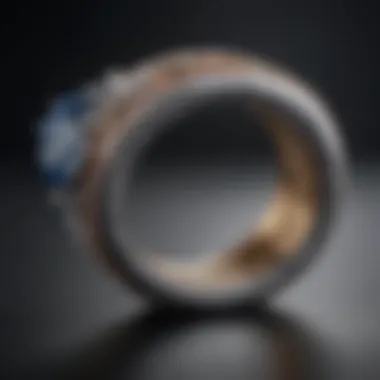
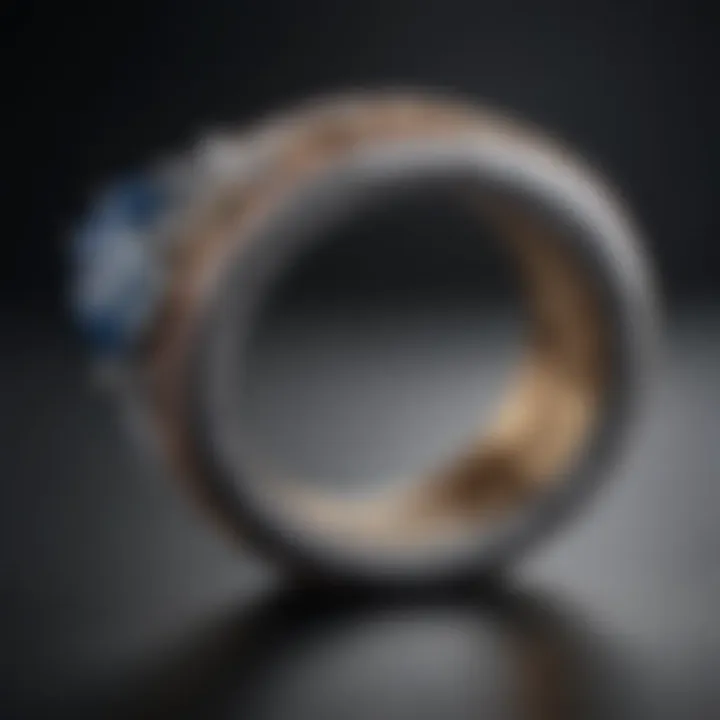
- Meticulous Attention to Detail: Rings should be assessed for how well the stones are set, if applicable, and how evenly the metal is polished. Every nook and cranny matter.
- Design Uniqueness: Is the ring simple, or does it feature intricate designs? Unique patterns or unusual settings can elevate a ring’s desirability and value.
"Quality in jewelry is as much about the story as it is about the materials. The craftsmanship imbues the piece with character and differentiation in a saturated market."
- Durability Considerations: How has the ring been finished? High-quality rings often undergo additional treatments, such as rhodium plating, to enhance luster and resistance to tarnishing.
In summary, quality assessment brings clarity to the often murky waters of the jewelry market. By mastering the art of identifying authentic pieces and understanding the hallmarks of superior craftsmanship, collectors can cultivate a collection that stands the test of time.
Consumer Considerations
Where to Purchase Ec Rings
Finding the right venue to acquire 925 ec rings is as critical as the decision to buy them. Various channels provide opportunities to purchase these stunning pieces:
- Local Jewelers: Visiting a nearby jeweler can be beneficial. They often have a selection that allows you to experience the ring's craftsmanship firsthand. You can ask questions and receive immediate answers, building trust in your purchase.
- Online Marketplaces: Websites such as Etsy or Amazon often feature a variety of sellers offering unique designs. However, it’s crucial to check the seller's reviews and ratings before making a purchase.
- Specialty Shops: Some stores focus entirely on niche jewelry items. These spots often provide custom options, giving you the ability to create a piece that truly reflects your style.
- Auctions: For those interested in vintage or rare 925 ec rings, auctions can yield one-of-a-kind finds. Research is necessary to ensure that what you bid on is authentic and worth the investment.
How to Maintain and Care for Your Ring
Once you’ve acquired a 925 ec ring, maintaining its luster and integrity becomes paramount. Here are several practical tips for care:
- Regular Cleaning: Use a soft cloth to wipe your ring after wearing it. This helps remove oils and dirt that can dull its shine over time. For deeper cleaning, a gentle soap solution works wonders.
- Avoid Harsh Chemicals: Chemicals found in household cleaners or even certain cosmetics can damage the rhodium plating. It’s advisable to take off your ring before using such products.
- Storage: Keep your ring in a soft pouch or in a dedicated jewelry box away from other pieces to prevent scratches.
- Professional Maintenance: Consider visiting a jeweler every once in a while for a quick check-up. They can polish and replate the ring, ensuring it stays looking its best for years to come.
Investing time in understanding where to purchase and how to maintain your ring can significantly enhance its longevity and aesthetic appeal.
By paying close attention to these elements, consumers stand to appreciate their 925 ec rings not just as accessories, but as enduring pieces of artistry that require thoughtful care.
Future Trends in Ec Rings
The realm of 925 Ec rings is not stagnant; it's ever-evolving with dynamic shifts that mirror the preferences and desires of modern consumers. Exploring future trends in this jewelry niche allows enthusiasts and collectors to stay ahead of the curve, ensuring their collections remain relevant and appreciated. Understanding these trends not only enhances the collector's insight but also influences their decisions regarding purchases and investments.
Shifts in Consumer Preferences
Consumer preferences are like the wind, constantly changing direction. Today's buyers are more informed than ever and have heightened expectations regarding luxury and sustainability. For instance, many are drawn to ethical sourcing and want reassurance that their jewelry does not harm the environment. This has led to an increasing demand for rings that are not only stylish but also responsibly made.
The trend towards personalized and custom designs is also becoming more prominent. Shoppers no longer seek the generic; they want pieces that tell their story—be it through unique engravings, gemstone choices, or distinctive settings. Each ring becomes a narrative of individual taste, a souvenir of significant moments.
Additionally, the popularity of online shopping has reshaped how consumers approach the market. They’re likely to conduct extensive research and turn to reviews or community recommendations found on platforms like Reddit and Facebook. They value transparency, with many preferring businesses that provide detailed information about the jewelry's craftsmanship and origins.
"A ring can be more than just a piece of jewelry; it can symbolize relationships, milestones, and personal identity."
Innovations in Design and Materials
Innovation in design and materials is paving the way for a new era in 925 Ec rings. One significant trend is the incorporation of alternative materials. For instance, rings featuring lab-grown diamonds are becoming increasingly attractive due to their ethical appeal and affordability. Collectors are keen to mix traditional 925 sterling silver with modern elements like carbon fiber or leather accents, creating a hybrid that infuses everyday wear with flair.
Moreover, advancements in technology enable intricate designs that were almost impossible to achieve in the past. 3D printing is revolutionizing the jewelry-making process, allowing designers to produce highly complex shapes and detailed patterns. This can significantly enhance the customization aspect, resulting in one-of-a-kind pieces that cater to individual tastes.
Lastly, eco-friendly practices in jewelry making are on the rise. Many jewelers are embracing sustainable methods, using recycled silver and eco-conscious plating. This shift not only resonates with eco-aware consumers but also adds a unique story to each ring, establishing a bond between the wearer and the craft.
In summary, the future of 925 Ec rings is set to reflect a blend of personal expression and responsible fashion. By understanding these emerging trends, enthusiasts can better appreciate their collections and make informed decisions in their jewelry pursuits.
Ending
The conclusion serves as the anchor for all the discussions surrounding 925 ec rings. It’s essential to synthesize the intricate details laid out through each section, offering a clearer picture of why these rings hold significance in the jewelry market. The value of 925 ec rings isn’t just about the materials or craftsmanship; it encompasses history, cultural implications, and market trends.
In summary, 925 ec rings stand out due to their unique composition and quality. From the durability of sterling silver to the enhancements made by rhodium plating, knowing these aspects equips collectors and enthusiasts with a deeper appreciation for their rings. Each piece tells a story, reflecting both personal and universal narratives.
Moreover, understanding market dynamics adds another layer. Recognizing factors like consumer preferences can greatly aid those looking to invest in or collect these rings. This depth of knowledge not only informs purchasing decisions but also fosters a genuine connection with the jewelry.
"In the world of jewelry collecting, expertise breeds passion and investment."
Recap of Key Points
- Composition Matters: 925 ec rings are primarily made from sterling silver, providing a trustworthy base for jewelry that lasts.
- Craftsmanship: The artisan techniques involved in creating these rings highlight the time, skill, and artistry behind every piece.
- Cultural Significance: Rings often symbolize commitments, achievements, or personal milestones, enriching their personal value.
- Market Trends: Awareness of current market conditions and consumer demands can greatly influence buying and selling strategies.
- Quality Assessment: Knowing how to identify authentic 925 ec rings means avoiding common pitfalls in the purchase process.
Final Thoughts on Collecting Ec Rings
Collecting 925 ec rings should be seen as more than a simple hobby; it can become a deeply rewarding passion. These rings can capture moments in time, represent heartfelt connections, or even serve as a wise financial investment. For many, collecting jewelry is an art form, rich with emotion and significance.
When starting or expanding a collection, consider not just the aesthetic appeal but also the implications behind each ring. Is it linked to a family tradition? Does it reflect a significant milestone? Engaging with these questions can enhance the overall experience of collecting.
In this ever-evolving market, being informed is imperative. With trends shifting and new designs emerging, staying ahead means being thoughtful about each purchase. Ultimately, collecting 925 ec rings is about creating a personal narrative, celebrating milestones, and investing in pieces that carry both beauty and meaning.



